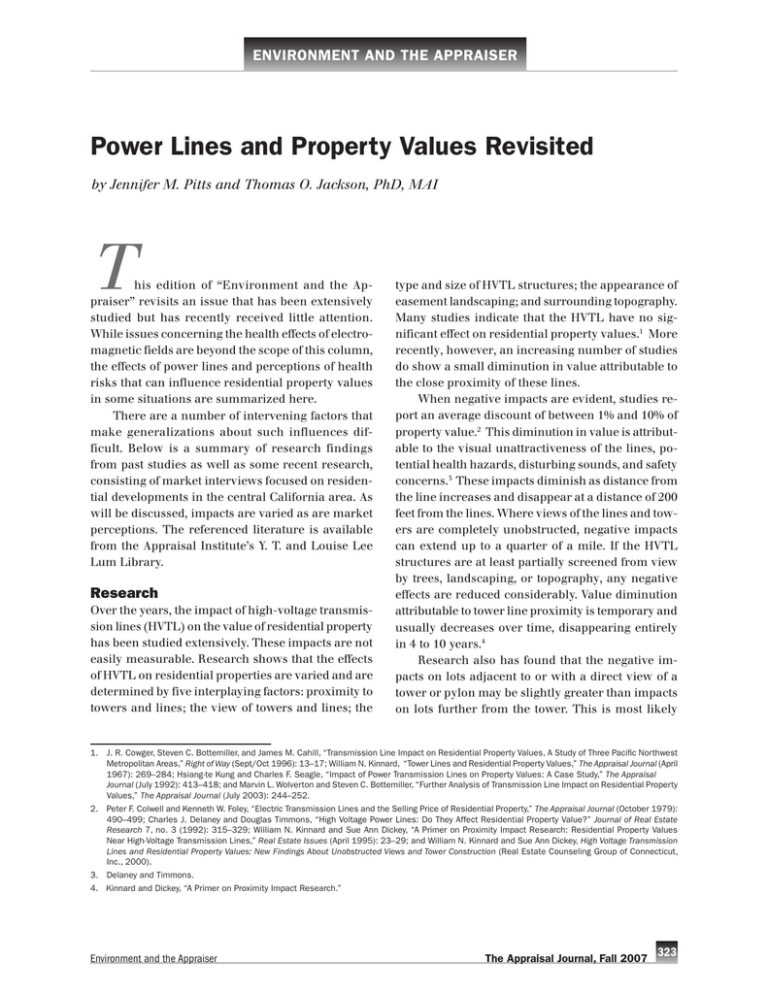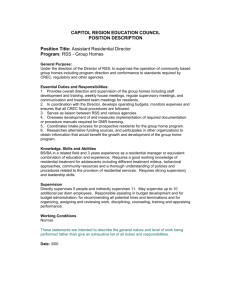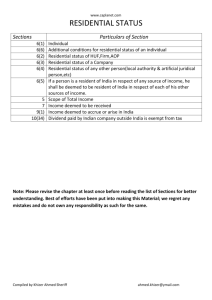T power Lines and property values revisited environment and the appraiser
advertisement

environment and the appraiser Power Lines and Property Values Revisited by Jennifer M. Pitts and Thomas O. Jackson, PhD, MAI T his edition of “Environment and the Appraiser” revisits an issue that has been extensively studied but has recently received little attention. While issues concerning the health effects of electromagnetic fields are beyond the scope of this column, the effects of power lines and perceptions of health risks that can influence residential property values in some situations are summarized here. There are a number of intervening factors that make generalizations about such influences difficult. Below is a summary of research findings from past studies as well as some recent research, consisting of market interviews focused on residential developments in the central California area. As will be discussed, impacts are varied as are market perceptions. The referenced literature is available from the Appraisal Institute’s Y. T. and Louise Lee Lum Library. Research Over the years, the impact of high-voltage transmission lines (HVTL) on the value of residential property has been studied extensively. These impacts are not easily measurable. Research shows that the effects of HVTL on residential properties are varied and are determined by five interplaying factors: proximity to towers and lines; the view of towers and lines; the type and size of HVTL structures; the appearance of easement landscaping; and surrounding topography. Many studies indicate that the HVTL have no significant effect on residential property values.1 More recently, however, an increasing number of studies do show a small diminution in value attributable to the close proximity of these lines. When negative impacts are evident, studies report an average discount of between 1% and 10% of property value.2 This diminution in value is attributable to the visual unattractiveness of the lines, potential health hazards, disturbing sounds, and safety concerns.3 These impacts diminish as distance from the line increases and disappear at a distance of 200 feet from the lines. Where views of the lines and towers are completely unobstructed, negative impacts can extend up to a quarter of a mile. If the HVTL structures are at least partially screened from view by trees, landscaping, or topography, any negative effects are reduced considerably. Value diminution attributable to tower line proximity is temporary and usually decreases over time, disappearing entirely in 4 to 10 years.4 Research also has found that the negative impacts on lots adjacent to or with a direct view of a tower or pylon may be slightly greater than impacts on lots further from the tower. This is most likely 1. J. R. Cowger, Steven C. Bottemiller, and James M. Cahill, “Transmission Line Impact on Residential Property Values, A Study of Three Pacific Northwest Metropolitan Areas,” Right of Way (Sept/Oct 1996): 13–17; William N. Kinnard, “Tower Lines and Residential Property Values,” The Appraisal Journal (April 1967): 269–284; Hsiang-te Kung and Charles F. Seagle, “Impact of Power Transmission Lines on Property Values: A Case Study,” The Appraisal Journal (July 1992): 413–418; and Marvin L. Wolverton and Steven C. Bottemiller, “Further Analysis of Transmission Line Impact on Residential Property Values,” The Appraisal Journal (July 2003): 244–252. 2. Peter F. Colwell and Kenneth W. Foley, “Electric Transmission Lines and the Selling Price of Residential Property,” The Appraisal Journal (October 1979): 490–499; Charles J. Delaney and Douglas Timmons, “High Voltage Power Lines: Do They Affect Residential Property Value?” Journal of Real Estate Research 7, no. 3 (1992): 315–329; William N. Kinnard and Sue Ann Dickey, “A Primer on Proximity Impact Research: Residential Property Values Near High-Voltage Transmission Lines,” Real Estate Issues (April 1995): 23–29; and William N. Kinnard and Sue Ann Dickey, High Voltage Transmission Lines and Residential Property Values: New Findings About Unobstructed Views and Tower Construction (Real Estate Counseling Group of Connecticut, Inc., 2000). 3. Delaney and Timmons. 4. Kinnard and Dickey, “A Primer on Proximity Impact Research.” Environment and the Appraiser The Appraisal Journal, Fall 2007 323 because the visual obstruction from a tower is more substantial than that from the lines themselves. The value diminution on lots adjacent to or with direct views on a tower may not decrease with time.5 A slower absorption rate and extended marketing period for residential properties adjacent to a tower line right-of-way are observed in some studies. However, when the nearby lots are attractively developed, the lots abutting a right-of-way will sell more quickly.6 It has also been found that higher-end custom homes are generally more sensitive to the negative impacts of HVTL than lower-end homes.7 While most research indicates that HVTL have no significant impact or a slight negative impact on residential properties, some studies have shown that lots adjacent to or with views of an HVTL right-of-way actually sell for a premium over more distant lots. This premium is most likely due to improved visual clearance, increased privacy, and larger lot sizes.8 Recent Market Interviews While academic and professional literature provide a broad background of findings on the price effects of HVTL, brokers and appraisers can provide additional perspective into current market conditions. In early 2007, interviews were conducted of local realtors and appraisers in several central California communities: Discovery Bay near Brentwood, Summer Lake near Oakley, and Sierra View in Roseville. HVTL right-of-ways run through or near these residential developments. Each realtor or appraiser was asked a series of questions about their background, market knowledge, and opinions on the effects of these high-voltage power lines.9 Approximately half of the realtors and appraisers interviewed said they had not observed negative impacts on either residential sale prices or days on market due to the presence of the power lines. According to these realtors and appraisers, major factors affecting sale price and marketability of residential properties include: location, the general economy, interest rates, inventory, and neighbor- hood amenities. A local appraiser in Discovery Bay commented that the presence of power lines “has not deterred residential development in Discovery Bay and surrounding areas.” A realtor in Oakley agreed, stating that “buyers are building and selling homes near power lines in many areas of California, and the power lines don’t seem to deter buyers.” The remaining realtors and appraisers interviewed had observed negative impacts on homes directly adjacent to a power line right-of-way. They said that on average, the indicated price discounts ranged between 2% and 7% for adjacent homes. For homes not directly adjacent but with a view of the power lines, average price impacts were estimated between 0% and 5%, depending on the view and proximity to the lines. On average, homes adjacent to or with a view of the lines could anticipate an increase of 0 to 60 days on the market. None of the realtors or appraisers interviewed had observed any negative impacts on residential properties in close proximity to the lines, but without a direct view. Many realtors and appraisers indicated that price and marketability effects of HVTL depend on the market conditions at the time of sale. The presence of power lines can be viewed as a negative externality. Externalities, as defined in the Appraisal Institute’s The Appraisal of Real Estate, 12th edition, are “the use or physical attributes of properties located near the subject property, or the economic conditions that affect the market in which the subject property competes.”10 According to a broker active in Discovery Bay, “the negative effects from the power line (and from other negative externalities) are evident in a slow market. When demand is strong, these effects diminish. The price effects depend on property characteristics and market conditions.” Another realtor in Roseville agreed, stating, “In a slow market, homes adjacent to a power line are harder to sell. These homes are great investment opportunities in a slow market, because any price effects diminish and may disappear when the market picks up.” 5. Peter F. Colwell, “Power Lines and Land Value,” Journal of Real Estate Research 5, no. 1 (1990): 117–127. 6. Louie Reese, “The Puzzle of the Power Line,” The Appraisal Journal (October 1967): 555–560. 7. Francois Des Rosiers, “Power Lines, Visual Encumbrance and Home Values: A Microspatial Approach to Impact Measurement,” Journal of Real Estate Research vol. 23, no. 3 (2002). 8. Delaney and Timmons; and Des Rosiers. 9. Interviews conducted by Real Property Analytics, Inc., January 2007. For methodology, see Thomas O. Jackson, “Surveys, Market Interviews, and Environmental Stigma,” The Appraisal Journal (Fall 2004): 300–310. 10. Appraisal Institute, The Appraisal of Real Estate, 12th ed. (Chicago: Appraisal Institute, 2001), 42. 324 The Appraisal Journal, Fall 2007 Environment and the Appraiser The impact of the power lines on residential property values may also be influenced by a buyer’s personal preference. Several realtors and appraisers indicated that there might not be a market consensus on the impacts of power lines because some buyers may consider these power lines a nuisance and an eyesore, while other buyers do not. A broker in Discovery Bay stated, “personal preference may cause some buyers to locate further from the power lines, but the lines have caused no observable negative impacts for the market in general.” Another Discovery Bay realtor stated, “external factors such as power lines have less of an effect on lower-end homes than on luxury properties.” Conclusion Both the market interviews and academic literature show that the impacts of power lines on residential properties are varied and difficult to measure. The impacts from the power lines, as well as other negative externalities, depend on many factors, including market condition, location, and personal preference. Environment and the Appraiser Jennifer M. Pitts researches environmental issues and their effects on real estate markets for Real Property Analytics, Inc. She received her master’s degree in land economics and real estate from Texas A&M University. Pitts also has a bachelor’s degree, summa cum laude, in finance from the Mays Business School at Texas A&M. Contact: T 254-760-0847; E-mail: jennifer@ real-analytics.com Thomas O. Jackson, PhD, MAI, CRE, is a clinical associate professor in the Department of Finance of the Mays Business School at Texas A&M University, where he teaches real property valuation in the Land Economics and Real Estate Program. In addition, he is the president of Real Property Analytics, Inc., based in College Station, Texas, where he specializes in analyzing the effects of environmental contamination on real property. Contact: T 979-690-1755; E-mail: tomjackson@ real-analytics.com; Web site: www.real-analytics.com The Appraisal Journal, Fall 2007 325






